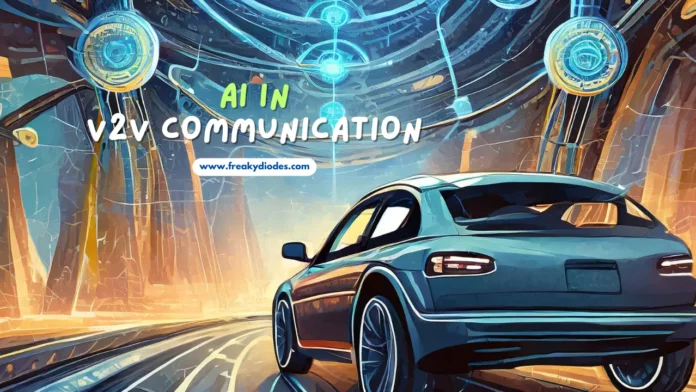The AI Impact on Vehicle-to-Vehicle Communication | How AI Transforms Vehicle-to-Vehicle Communication| Exploring AI’s Role in V2V Communication | The Intersection of AI and Vehicle Safety | AI’s Journey in Enhancing V2V Communication | The Transformative Role of Artificial Intelligence in Vehicle-to-Vehicle Communication
In the dynamic landscape of transportation, the integration of Artificial Intelligence (AI) has emerged as a transformative force, particularly within the realm of Vehicle-to-Vehicle (V2V) communication. This article delves into the multifaceted impact of AI on V2V communication, exploring its implications for safety, traffic management, autonomous mobility, and integration with smart infrastructure.
Understanding Vehicle-to-Vehicle (V2V) Communication
V2V communication stands as a revolutionary technology aimed at preemptively averting accidents by enabling vehicles to exchange crucial driving data via specialized wireless networks termed VANETs. Through VANETs, vehicles transmit and receive real-time information about their speed, location, acceleration, and other relevant parameters, creating a networked ecosystem where vehicles collaboratively navigate the roadways.
Elevating Safety Standards through AI
Safety lies at the core of transportation, and AI-powered V2V communication holds immense promise in bolstering this critical aspect. By harnessing AI algorithms, vehicles can exchange vital information in real-time, facilitating a proactive approach towards mitigating potential hazards. AI algorithms analyze extensive datasets to detect patterns and anomalies, empowering vehicles to preemptively identify precarious situations like sudden braking or lane departures. This proactive stance towards safety empowers vehicles to take evasive actions autonomously, thereby minimizing the likelihood of collisions and ensuring the safety of both occupants and pedestrians.
Exciting opportunities await! Stay connected with us and to be the first to know about the latest tech internships, jobs, and more.
Optimizing Traffic Management with AI
Traffic congestion remains a persistent challenge in urban landscapes, leading to wasted time, fuel, and heightened carbon emissions. AI-driven V2V communication presents a viable solution by optimizing traffic flow through intelligent coordination and synchronization of vehicles. By facilitating the exchange of information regarding traffic conditions, road closures, and alternate routes, vehicles can dynamically adjust their speeds and routes to circumvent congested areas, thus reducing gridlock and enhancing overall traffic efficiency. Furthermore, AI algorithms can facilitate smoother merging and lane changes, thereby minimizing disruptions and fostering a seamless flow of traffic.
Enabling Autonomous Mobility through AI
The evolution of autonomous driving technology hinges on effective V2V communication powered by AI. As vehicles progress towards higher levels of autonomy, the ability to exchange real-time data with neighboring vehicles becomes imperative for safe and efficient operation. AI algorithms play a pivotal role in enabling autonomous vehicles to interpret and respond to the diverse array of inputs received from surrounding vehicles. From predicting the behavior of nearby vehicles to orchestrating intricate maneuvers such as intersection crossings and lane changes, AI empowers autonomous systems to navigate the roadways with confidence and precision.
Facilitating Integration with Smart Infrastructure
In addition to fostering vehicle-to-vehicle communication, AI facilitates seamless integration with smart infrastructure components such as traffic lights, road signs, and pedestrian crossings. By harnessing AI algorithms, vehicles can communicate with infrastructure elements to optimize traffic signal timings, prioritize emergency vehicles, and enhance pedestrian safety. Furthermore, AI enables vehicles to interpret and respond to traffic signage and signals, providing an additional layer of guidance and situational awareness. This integration of AI-driven V2V communication with smart infrastructure lays the groundwork for a connected transportation ecosystem that is responsive, adaptive, and inherently safer.
The Road Ahead for AI in V2V Communication
As AI continues to advance, the possibilities for enhancing V2V communication are virtually limitless. With ongoing research and development efforts, we can expect to see further improvements in safety, efficiency, and overall mobility. However, challenges such as data privacy, cybersecurity, and regulatory compliance must be addressed to ensure the widespread adoption and success of AI-powered V2V communication systems.
In conclusion, the integration of AI in V2V communication represents a paradigm shift in transportation, offering unprecedented opportunities to enhance safety, efficiency, and mobility on the roadways. By harnessing the power of AI algorithms, vehicles can communicate, collaborate, and navigate with greater precision and foresight, paving the way for a future where accidents are minimized, congestion is mitigated, and transportation is truly intelligent.
Also Read..
| Join Our Telegram Channel | Click Here |
| Join Our Whatsapp Group | Click Here |
| Follow us on LinkedIn | Click Here |
| Follow us on Facebook | Click Here |
| Follow us on Instagram | Click Here |








